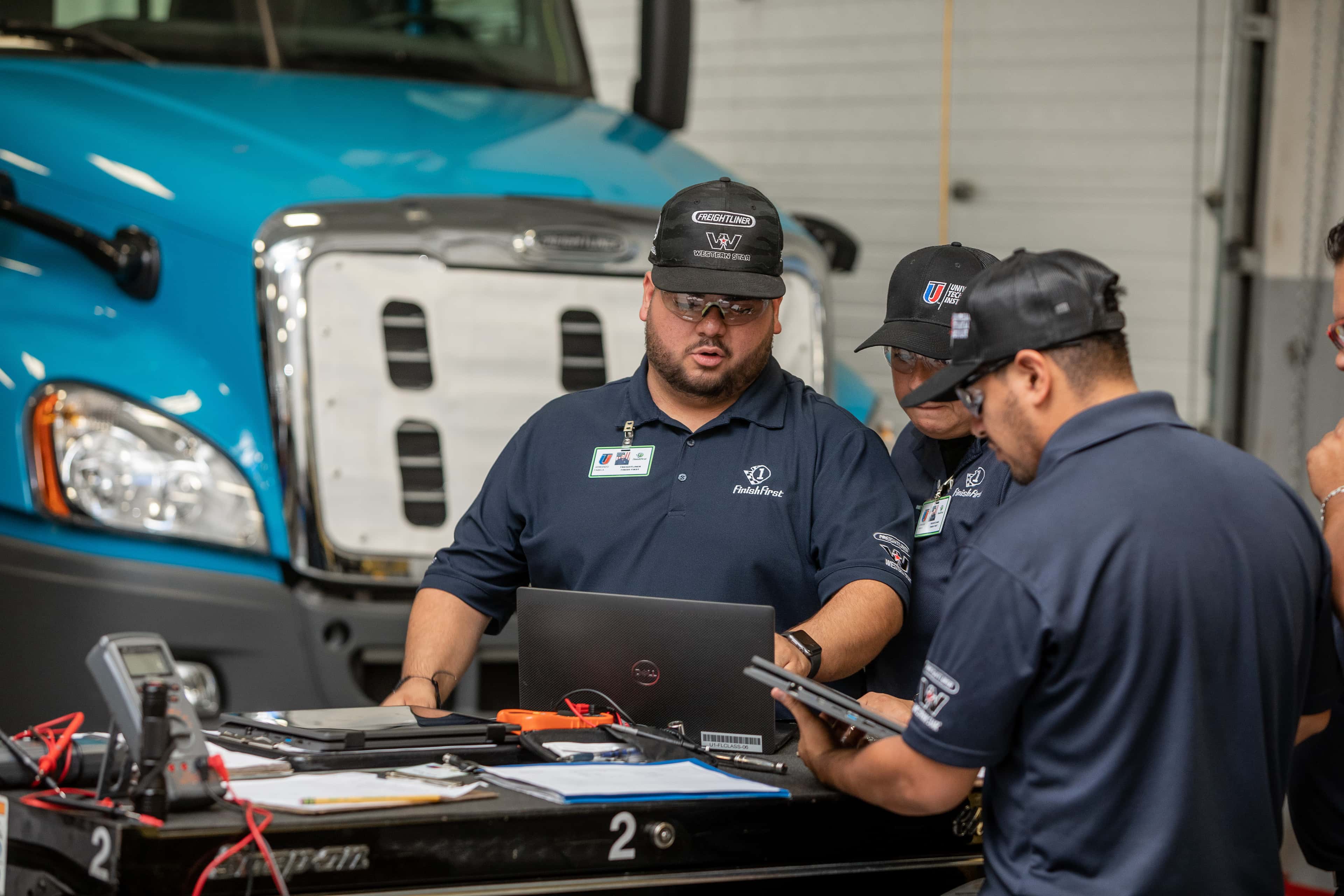Modern diesel engines are smarter and more complex than ever. As a result, diesel technicians today rely heavily on onboard computer systems and diagnostic tools to maintain performance and keep trucks and equipment running smoothly. One thing techs should be aware of is diagnostic trouble codes or DTCs.
In Universal Technical Institute’s Diesel Technology program, students learn skills needed to diagnose issues with diesel engines and related systems, becoming familiar with DTCs as a part of the process.1
Keep reading to learn about what diesel DTCs are, why they matter and get an overview of seven of the most important codes diesel techs should recognize.
What Is a Diesel Diagnostic Trouble Code?
Diagnostic trouble codes are standardized five-character codes generated by a vehicle’s engine control module (ECM). These codes are designed to alert technicians to specific issues detected by various sensors within the engine or emissions systems. Each DTC begins with a letter, such as “P” for powertrain, followed by four numbers that further define the issue.
For example, a code like P0401 refers to an exhaust gas recirculation issue, while P0087 relates to low fuel pressure. Reading these codes with a scan tool is the first step in diagnosing and resolving problems efficiently.
Why Is It Important for Diesel Technicians to Understand These Codes?
For a diesel technician, understanding DTCs is critical. These codes offer a shortcut to identifying the root cause of performance issues without the guesswork. When technicians can read and interpret codes quickly, they can make accurate repairs and minimize vehicle downtime, which is an essential skill in industries that rely on diesel-powered transportation and equipment.
By becoming comfortable with the interpretation of diagnostic trouble codes, diesel techs can troubleshoot problems, improve service turnaround times, and ensure reliability and compliance with emissions standards. Courses in UTI’s Diesel program are designed to help students become familiar with these DTC codes.
Read on to learn about some of the more common DTC codes!
P0087: Fuel Rail/System Pressure Too Low
This code indicates that the fuel rail pressure is lower than expected. This can be caused by a number of things, including a faulty fuel pump, clogged fuel filter, fuel pressure sensor malfunction or leaking fuel lines.
P0299: Turbocharger/Supercharger Underboost Condition
DTC P0299 indicates that the turbocharger or supercharger isn't producing enough boost pressure. Potential causes may be a leaking intercooler hose, blocked air intake or exhaust, or faulty turbo actuator.
P0401: Exhaust Gas Recirculation (EGR) Flow Insufficient Detected
This diagnostic code means that the EGR system isn’t allowing enough exhaust gas back into the intake system to reduce emissions. Causes could be a clogged EGR valve or cooler, a broken or stuck EGR valve, or a faulty EGR sensor.
P2463: Diesel Particulate Filter (DPF) Restriction – Soot Accumulation
P2463 indicates that the DPF is clogged with excessive soot, leading to restricted exhaust flow. This can be caused by sensor failure or delayed or incomplete regeneration cycles.
P0193: Fuel Rail Pressure Sensor Circuit High Input
This code indicates the sensor is detecting abnormally high pressure or sending faulty high-voltage signals. Potential causes could be ECM malfunction, wiring or connector issues, or a faulty fuel pressure sensor.
P2002: Diesel Particulate Filter Efficiency Below Threshold
Code P2002 means the ECM has determined the DPF isn’t effectively reducing emissions. Causes of this issue may be a failed DPF, bad exhaust sensors or repeated failed regeneration.
P0113: Intake Air Temperature Sensor 1 Circuit High Input
This code means the intake air temperature sensor is reading a voltage that’s too high, usually indicating a cold intake or sensor issue. It could be caused by a broken wire or poor connector.
4 Pro Tips for Managing DTCs
Only use reliable diagnostic tools
Invest in professional-grade scan tools that are compatible with diesel vehicles and offer accurate readings.
Prioritize codes when necessary
Some codes may be symptoms, not root causes. Focus on primary codes and address underlying issues first.
Continuously monitor engine parameters
Use live data readings to get context around when and how the fault occurs. This helps in pinpointing intermittent problems.
Always record and clear codes
Log the codes before clearing them. This gives you a repair history and can help you identify recurring problems over time.
Train To Prepare for a Diesel Technician Career with UTI
Diesel engines are the backbone of transportation, logistics, agriculture and construction. With technology advancing rapidly, today’s diesel technician needs more than just mechanical know-how. They need to understand how to diagnose and fix issues using diagnostic trouble codes and electronic tools.
At UTI, students in the Diesel Technology program learn how to work with DTCs, diagnostic equipment, ECM systems and engines. From basic troubleshooting to complex repairs, you’ll get hands-on training that prepares graduates for the demands of the industry.
Take the next step. Enroll in our Diesel program and start training to pursue a career that’s in demand and built for the future.
Universal Technical Institute of Illinois, Inc. is approved by the Division of Private Business and Vocational Schools of the Illinois Board of Higher Education.

